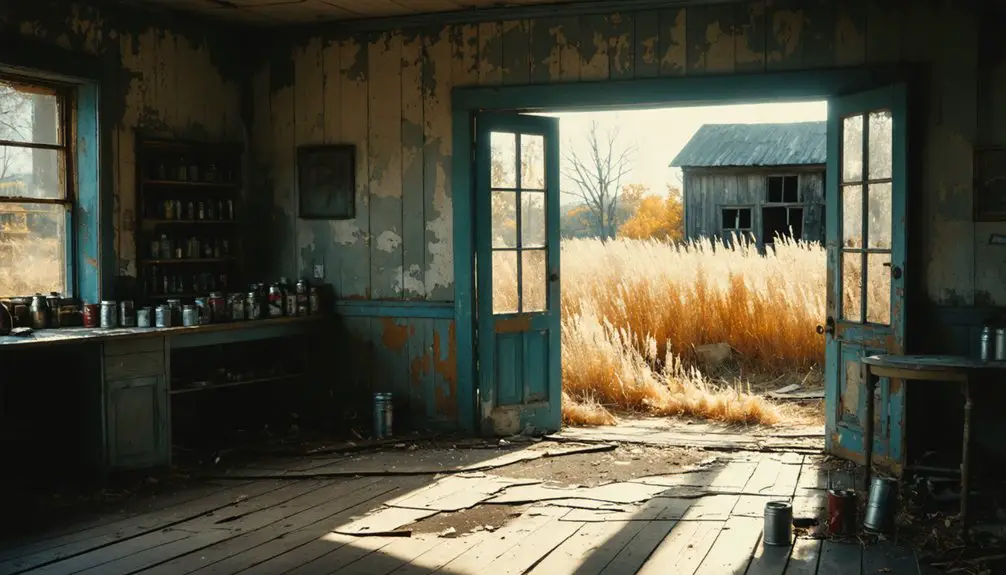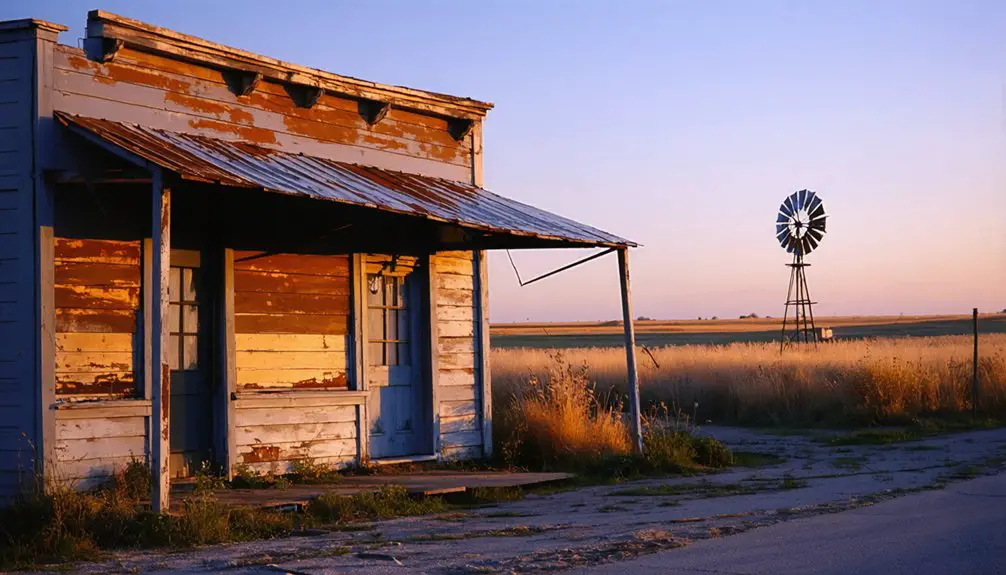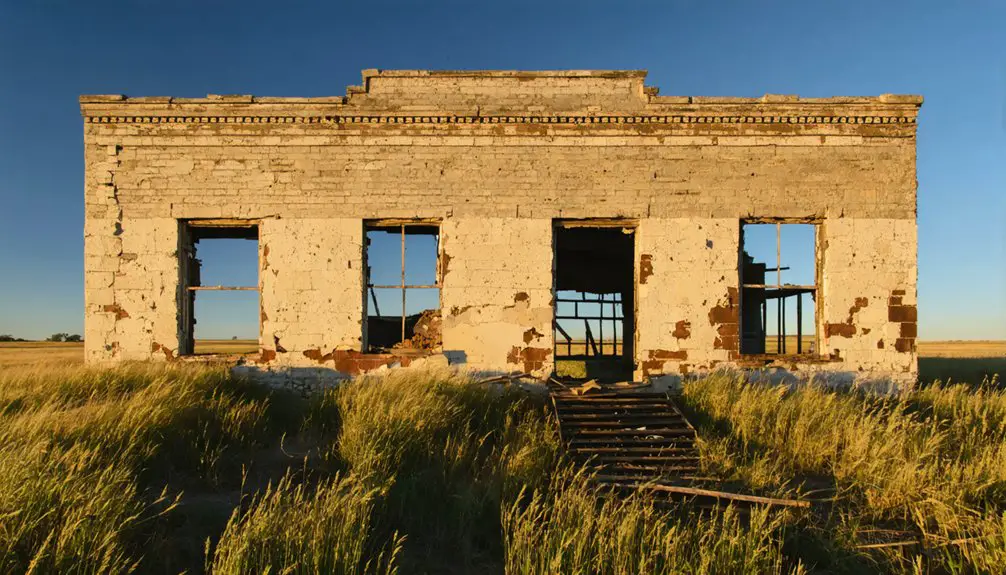You’ll find Beaver, Kansas transformed from a bustling agricultural powerhouse to a resilient ghost town of 52 residents. In 1930, the area boasted 2,518 farms producing 2.9 million bushels of wheat, but the Dust Bowl, mechanization, and shifting transportation routes sparked its decline. Today, you can still see operational grain elevators, oil pumps, and historic structures from the early 1900s dotting the landscape, each telling a story of this once-thriving farming community.
Key Takeaways
- Population declined from a thriving agricultural community to just 52 residents, qualifying Beaver as a near-ghost town.
- Economic decline stemmed from agricultural mechanization, the Dust Bowl, and isolation from major transportation routes.
- Historic business district contains abandoned structures from early to mid-20th century, including gas stations and retail spaces.
- The town maintains minimal services with a functioning fire department, gas station, and grain elevators despite severe depopulation.
- Local farm numbers dropped dramatically from 2,518 in 1930 to 1,370 by 1950 due to consolidation and economic pressures.
The Rise of an Agricultural Hub
While many small Kansas towns emerged as agricultural centers in the mid-20th century, Beaver’s transformation began with the establishment of Beaver Valley Feed & Seed Co. in the early 1940s.
Beaver Valley Feed & Seed Co. sparked the small town’s evolution into a vital Kansas agricultural center during the 1940s.
You’ll find that agricultural innovation quickly followed as the company expanded into farm equipment distribution by 1956, strengthening the local farming infrastructure.
Joseph F. Vap established the company and led its early growth, serving the local area with essential agricultural supplies.
The founding of Beaver Grain Corp in 1958 marked another milestone, offering essential services like grain storage and marketing solutions.
Through community collaboration, these businesses created a robust support system for local farmers, providing everything from seed services to crop management.
The 1970s brought further growth when Beaver Valley Supply Co. expanded its operations, relocating facilities in 1974 to better serve the region’s agricultural needs.
Together, these developments positioned Beaver as a significant hub for farming operations throughout Barton County.
The town’s decline became evident when the post office closed in 1992, marking a significant shift in the community’s services.
Daily Life in Early Beaver
Life in early Beaver revolved around ranching families who settled near Beaver Creek in the 1880s.
The earliest ranchers in the county included John Bray and Darling who established their operations in spring 1880.
You’d start your daily routines before sunrise, tending to cattle and sheep, maintaining fences, and ensuring water sources for livestock. When you weren’t working the ranch, you’d likely find yourself at community gatherings in makeshift buildings that served multiple purposes.
Like the Ute tribe before them, settlers relied heavily on hunting deer, elk and buffalo to supplement their food supply.
Your home would’ve been a simple wooden structure without modern amenities – you’d draw water from wells or the creek.
During harsh winters, you’d hunker down in your cabin, relying on stored supplies. Community gatherings at the general store, church, or schoolhouse provided essential social connections.
You’d share news at the post office, participate in barn raisings, and join neighbors for dances and communal meals, building bonds that helped everyone survive frontier life.
Economic Forces Behind the Decline
You’ll find that Beaver’s agricultural foundation weakened as family farming became less profitable due to rising operational costs and declining soil productivity in the region.
The industrialized farming methods gradually replaced traditional agricultural practices, further accelerating the town’s decline.
Like many small farming communities during the Dust Bowl era, Beaver suffered significant population losses as agricultural challenges mounted.
The town’s isolation from major transportation routes proved devastating when new highways and interstates redirected traffic and commerce away from smaller communities.
These infrastructure changes, combined with the mechanization of farming that reduced local labor needs, created a perfect storm that steadily eroded Beaver’s economic viability.
Agricultural Industry Evolution
As Beaver’s agricultural industry entered the early 20th century, a period of remarkable prosperity took hold through the rise of dry land farming techniques and wheat production.
You’d have seen traditional ranchers giving way to “pumpkin rollers” who transformed the landscape with innovative wheat cultivation. By 1920, 2,518 farms dotted the region, producing an impressive 2.9 million bushels of wheat by 1930. The state’s modern commodity agriculture system has eliminated the need for many small independent operations.
But you couldn’t outrun nature forever. Despite farming innovations and attempts at crop rotation, the moldboard plow’s intensive use left soil vulnerable. The Dust Bowl era devastated local agriculture throughout the 1930s.
When the 1930s drought hit, it triggered a devastating cascade. Farms consolidated, shrinking to 1,370 by 1950. Technology brought bigger yields but required massive investment, forcing smaller operations to sell.
The industry’s evolution pushed toward fewer but larger farms, forever changing Beaver’s agricultural character.
Transportation Infrastructure Impact
When railroad service began diminishing in Beaver during the mid-20th century, the town’s economic lifeline started unraveling.
You’d have seen the cascading effects as major transportation routes shifted away from this once-bustling Kansas community. Rail abandonment meant local businesses could no longer ship goods cost-effectively, while highway reroutings diverted essential customer traffic elsewhere.
The economic shifts hit hard as larger neighboring towns, with their superior transportation infrastructure, drew commerce and residents away from Beaver. Similar to other communities facing economic depressions, Beaver’s commercial activity declined sharply as businesses closed their doors. Like Virginia City’s fate after 1890, Beaver experienced a dramatic population decline as residents sought opportunities elsewhere.
You’ll find this reflected in the closure of the post office in 1992 and the consolidation of local schools. Without adequate road networks to capitalize on the trucking boom, Beaver couldn’t compete with regional hubs.
Notable Landmarks and Structures
As you explore Beaver today, you’ll notice the prominent grain storage facilities operated by Beaver Grain Corp, which has served the agricultural community since 1958.
The town’s landscape includes several historic business buildings that remain standing as silent witnesses to Beaver’s more vibrant past.
Active oil well pumps dot the surrounding area, representing the town’s continued connection to energy production despite its ghost town status.
Grain Storage Facilities
The Beaver Grain Corp, established in 1958, stands as the oldest operating business in the ghost town of Beaver, Kansas. Located at NE 190 Rd and NE 60 Ave, this historic facility continues to serve local farmers with grain storage innovations and marketing solutions.
You’ll find these grain elevators as key landmarks that have persisted despite the town’s decline.
The site’s evolution mirrors the broader transformation of grain preservation techniques in Kansas. What began as modest storage operations expanded considerably during the post-WWII era, with metal flat storage facilities introduced in the 1950s replacing older wooden structures.
Today, Beaver Grain Corp remains an essential agricultural hub, offering crop management and seed services. While most businesses in Beaver have vanished, these grain facilities continue supporting the region’s farming community.
Historic Business Buildings
Despite its declining population, Beaver’s historic business district preserves several notable structures that tell the story of this once-thriving Kansas community.
You’ll find gas stations, agricultural service buildings, and retail spaces that showcase the town’s historic architecture from the early to mid-20th century.
The town’s community heritage lives on through various commercial landmarks, including mixed-use buildings where shop owners once lived above their businesses.
These structures reflect the practical needs of rural Kansas life, combining family homes with retail spaces.
While walking through Beaver, you’ll notice simple yet functional designs in the buildings that supported local trade, automotive services, and farming operations.
Though many now stand empty, these buildings remain as proof of the town’s entrepreneurial spirit and economic importance.
Oil Well Operations
Beyond Beaver’s historic business district, oil well operations shaped the town’s industrial landscape throughout the early 1900s. Following early oil discoveries, companies like Ohio-Kansas Oil & Gas secured thousands of acres for exploration.
You’d find working rigs dotting the landscape, like those at the Harmon Lease constructed around 1918. The drilling techniques evolved from simple vertical wells to more sophisticated operations.
While some wells produced oil naturally, many required pumping plants to extract the crude. Storage tanks and pipelines became familiar sights as production ramped up.
The Legacy of Beaver Grain Corp
Since 1958, Beaver Grain Corp has stood as a pillar of agricultural support in Barton County, Kansas, growing from a local grain storage facility into the area’s leading independent agricultural service provider.
From humble grain storage roots, Beaver Grain Corp emerged as Barton County’s trusted agricultural cornerstone since 1958.
You’ll find this grain legacy continues under Brian Hoffman’s board leadership and Scott Schlochtermeier’s management, offering essential services from feed mixing to soil testing at their 1905 Main Street location.
Despite Beaver’s shift toward ghost town status, with its post office and school now closed, the corporation’s community resilience shines through.
Operating six days a week, they’ve maintained their position as the oldest continuously running business in town.
Through their extensive agricultural services, including custom applications and equipment rental, they’ve helped sustain the region’s farming economy while adapting to the sector’s evolving needs.
From Bustling Town to Ghost Town

When Beaver established its post office on June 19, 1919, the small agricultural town promised a bright future as an essential service center for Barton County’s farming community.
You’d have found thriving businesses, a local school, and grain elevators supporting the area’s farmers.
But progress brought unexpected challenges. As transportation improved and agricultural markets became more mobile, you couldn’t help but notice the town’s declining importance.
The school’s closure forced students to attend Central Plains USD 112 in Claflin, weakening community cohesion.
Population migration accelerated as mechanization reduced farming jobs, and competition from larger towns drew businesses away.
Modern-Day Remnants and Activity
Today, Beaver stands as a symbol of rural endurance with a modest population of 52 residents.
You’ll find glimpses of the town’s agricultural heritage through Beaver Grain Corp, which has operated since 1958 and continues to serve local farmers with storage, marketing, and crop management services.
While many buildings show their age, you’ll notice active community dynamics through the functioning fire department and gas station.
Though the post office closed in 1992, the landscape features operational grain elevators and oil well pumps.
Children attend schools in nearby districts, maintaining regional connections despite local school closure.
The mix of inhabited homes, abandoned structures, and agricultural fields tells a story of adaptation.
You’ll see how this small community preserves its identity through ongoing agricultural services and basic infrastructure, even as nature slowly reclaims parts of its streets.
Preserving Beaver’s Historical Significance

Through dedicated documentation efforts, Beaver’s historical significance lives on despite its diminishing population.
You’ll find evidence of the town’s rich agricultural heritage in the still-operating Beaver Grain Corp, established in 1958, which continues to serve local farmers. Historical tourism opportunities center around the preserved grain elevators and old business buildings that tell the story of this once-thriving farming community.
Community engagement persists through the preservation of important records and structures.
Local residents maintain their community’s legacy by actively protecting and documenting their historical buildings and documents.
While the post office closed in 1992 and the local school has consolidated into Central Plains USD 112, these changes are documented in county archives and local histories.
The town’s transformation from an active agricultural center to a census-designated place with 52 residents represents an important chapter in Kansas’s rural development story.
Frequently Asked Questions
What Was the Highest Recorded Population of Beaver During Its Peak Years?
You won’t find the highest population records during Beaver’s peak years, as historical data doesn’t specify exact population trends before its decline to today’s 52 residents.
Were There Any Churches or Religious Institutions Established in Beaver?
Like a fading footprint in time, you won’t find direct church history in Beaver itself. Instead, you’ll discover religious significance nearby in Kackley’s Baptist and Pentecostal churches serving the township’s faithful.
Did Beaver Have a Newspaper or Local Publication During Its Existence?
You won’t find evidence of local journalism in Beaver’s historical archives. The town likely relied on regional newspapers from larger nearby communities for news coverage throughout its existence.
What Native American Tribes Originally Inhabited the Area Before Beaver’s Establishment?
Like ancient spirits across untamed prairies, you’d find the fierce Kiowa and Comanche warriors roaming freely, while the Kaw Tribe and Osage Nation maintained deep ancestral connections to these rolling grasslands.
Has Beaver Ever Experienced Significant Natural Disasters or Severe Weather Events?
You’ll find historical records of severe blizzards in 1886 that devastated local cattle, plus recurring dust storms and high winds. While tornado history and flood impact aren’t extensively documented, extreme weather’s shaped your region.
References
- https://octa-trails.org/wp-content/uploads/2023/05/Ellis-Uniontown-and-Plowboy–-Potawatomi-Ghost-Towns.pdf
- https://legendsofkansas.com/beaver-kansas/
- https://fhsuguides.fhsu.edu/kansasheritage/rawlinscounty
- https://www.potawatomi.org/blog/2024/10/31/researchers-search-for-uniontown/
- https://www.youtube.com/watch?v=5UTFd2JlelY
- https://beavervalleysupply.com/our-history/
- https://www.ksre.k-state.edu/historicpublications/pubs/Agron_Cent.pdf
- https://en.wikipedia.org/wiki/North_American_beaver
- https://ecommons.cornell.edu/server/api/core/bitstreams/403fa140-57c0-4397-b7b8-9172c196a6dd/content
- https://fhsuguides.fhsu.edu/kansasheritage/shermancounty



